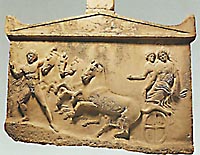Votive reliefs should probably be connected either with earlier wooden reliefs or with inscribed plaques dedicated at shrines. They appeared in Attica at the same time as tomb reliefs made their reappearance. They were normally a low parallelogram shape, with a crowning pediment. The person dedicating the monument was often shown on it. As a rule, human beings were smaller in size than the gods and heroes who waited to welcome them - often lying on a couch, a pose associated with funerary banquets and, fairly obviously, with the heroification of the dead person. The gods most often depicted were Artemis, Pan, Dionysus, Pluto, and - from the 4th century onwards - Asclepius. Other members of the cast were Amphiaraus and Hygieia; the Dioscuri; Zeus 'Philius'; and river gods (for example, Achelous). |
 |




